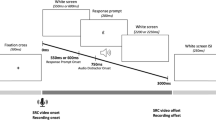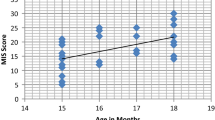Abstract
Two methods of language instruction administered to mentally retarded subjects at the two-word stage of language development were investigated. Subjects of the mimicry training group imitated Agent-Action-Object (AAO) constructions immediately after presentation, while subjects of the imitative modeling group first heard the AAO presentation and later produced the AAO construction in response to a verb question. Imitative modeling subjects achieved as many correct AAO responses during training and more correct responses on a generalization task and in a free play setting. They also displayed more novel response behavior (selective imitations) and spontaneously corrected productions. The results support the use of modeling procedures for inducing language production in the retarded.
Similar content being viewed by others
References
Bandura, A. (1971).Social Learning Theory, General Learning Press, New York.
Bandura, A. (1972). Modeling theory: Some traditions, trends and disputes. In Parks R. D. (ed.),Recent Trends in Social Learning Theory, Academic Press, New York.
Bandura, A., and Harris, M. A. (1966). Modification of syntactic style.J. Exp. Child Psychol. 4:341–352.
Courtright, J. A., and Courtright, I. C. (1976). Imitative modeling as a theoretical base for instructing language disordered children.J. Speech Hear. Res. 19:655–663.
Garcia, E. (1974). The training and generalization of a conversational speech form in nonverbal retardates.J. Appl. Behav. Anal. 7:137–149.
Guess, D., Sailor, W., Rutherford, G., and Baer, D. (1968). An experimental analysis of linguistic development: The productive use of the plural morpheme.J. Appl. Behav. Anal. 1:297–306.
Lutzker, J. R., and Sherman, J. A. (1974). Producing generative sentence usage by imitation and reinforcement procedures.J. Appl. Behav. Anal. 7:447–460.
McLean, J. E. (1972) Introduction. In McLean, J. E., Yoder, D. E., and Schiefelbusch, R. L., (eds.),Language Intervention with the Retarded, University Park, Baltimore.
McLean, J. E., and Synder, L. K. (1977). A transactional approach to early language training: Derivation of a model system, U. S. Dept. of Health, Education and Welfare, Bureau of Education for the Handicapped, Final Report, Project No. R0077FPB, Jan. 31, George Peabody College, Nashville, Tennessee.
Muma, J. M. (1977). Language intervention strategies.Lang. Speech Hearing Serv. Schools 8:107–125.
Rosenthal, T. L., and Whitebook, J. S. (1978). Incentives vs. instruction in transmitting grammatical parameters with experimenter as model.Behav. Res. Ther. 8:189–196.
Rosenthal, T. L., Zimmerman, B. J., and Durning, K. (1970). Observationally induced changes in children's interrogative classes.J. Personal. Soc. Psychol. 16:681–688.
Schumaker, J., and Sherman, J. A. (1970). Training generative verb usage by imitation and reinforcement procedures.J. Appl. Behav. Anal. 3:273–287.
Shipley, E. F., Smith, C. S., and Gleitman, L. R. (1969). A study in the acquisition of language: Free responses to commands.Language 45:322–342.
Wheeler, A. J., and Sulzer, B. (1970). Operant training and generalization of a verbal response form in a speech-deficient child.J. Appl. Behav. Anal. 3:139–147.
Whitehurst, G. J., and Novak, G. (1973). Modeling, imitation training and the acquisition of sentence phrases.J. Exp. Child Psychol 16:332–345.
Whitehurst, G. J., and Vasta, R. (1975). Is language acquired through imitation?J. Psycholing. Res. 4:37–59.
Zimmerman, B. J., and Bell, J. A. (1972). Observer verbalization and abstraction in vicarious rule learning, generalization and retention.Dev. Psychol. 7:227–231.
Author information
Authors and Affiliations
Rights and permissions
About this article
Cite this article
Prelock, P.A., Panagos, J.M. Mimicry versus imitative modeling: Facilitating sentence production in the speech of the retarded. J Psycholinguist Res 9, 565–578 (1980). https://doi.org/10.1007/BF01068117
Issue Date:
DOI: https://doi.org/10.1007/BF01068117




